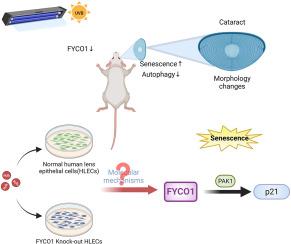FYCO1 regulates autophagy and senescence via PAK1/p21 in cataract
IF 3.8
3区 生物学
Q2 BIOCHEMISTRY & MOLECULAR BIOLOGY
引用次数: 0
Abstract
Background
ARC (Age-related cataract) is one of the leading causes of vision impairment and blindness; however, its pathogenesis remains unclear. FYCO1 (FYVE and coiled-coil domain containing 1) serves as an autophagy adaptor. The present study investigated the role of FYCO1 in cataract.
Methods
Ultraviolet-B (UVB) irradiation was used to establish a cataract mice model. Hematoxylin and eosin (H&E) assay were used to observe lens morphology. Cell models were constructed by cultivating SRA 01/04 cells with H2O2 and UVB. Cell counting kit-8 (CCK8) and Senescence-associated β-galactosidase (SA-β-Gal) assay were performed to explore proliferation and senescence. The gene and protein expression were assessed by quantitative real-time PCR (qRT-PCR), Western blot and immunofluorescence staining.
Results
We demonstrated lens structural damage and downregulation of FYCO1 in mice with UVB-induced cataracts. In vitro results revealed a deletion in autophagy levels along with the decrease of FYCO1 expression in human lens epithelial cells (HLECs) after H2O2 treatment, which was confirmed in vivo. The knockout of FYCO1 in the HLECs did not change basal autophagy and senescence but suppressed HLECs response in the induction of both. Further investigation indicated that FYCO1 knockout inhibited senescence and p21 levels by suppressing the expression of p21 activated kinase 1 (PAK1) in cataract cell models.
Conclusions
This study has newly characterized the role of FYCO1 in UVB-induced cataracts and in oxidative stress, both of which are associated with ARCs. A novel association between FYCO1 and PAK1/p21 in lens epithelial cell autophagy, senescence, and cataractogenesis also appears to have been established.

FYCO1在白内障中通过PAK1/p21调节自噬和衰老
背景:老年性白内障(ARC)是导致视力损伤和失明的主要原因之一,但其发病机制仍不清楚。FYCO1(FYVE and coiled-coil domain containing 1)是一种自噬适配子。本研究探讨了 FYCO1 在白内障中的作用:方法:用紫外线-B(UVB)照射建立白内障小鼠模型。方法:用紫外线-B(UVB)照射建立白内障小鼠模型,用苏木精和伊红(H&E)检测观察晶状体形态。用 H2O2 和 UVB 培养 SRA 01/04 细胞,构建细胞模型。用细胞计数试剂盒-8(CCK8)和衰老相关β-半乳糖苷酶(SA-β-Gal)检测法探讨细胞的增殖和衰老。通过实时定量 PCR(qRT-PCR)、Western 印迹和免疫荧光染色评估了基因和蛋白质的表达:结果:我们发现,在紫外线诱导的白内障小鼠中,晶状体结构受损,FYCO1 下调。体外实验结果表明,H2O2 处理后,人晶状体上皮细胞(HLECs)的自噬水平下降,FYCO1 的表达也随之减少。在 HLECs 中敲除 FYCO1 不会改变基础自噬和衰老,但会抑制 HLECs 对这两种诱导的反应。进一步的研究表明,在白内障细胞模型中,FYCO1基因敲除通过抑制p21活化激酶1(PAK1)的表达,抑制了衰老和p21水平:本研究新近揭示了 FYCO1 在紫外线诱导的白内障和氧化应激中的作用,这两种作用都与 ARCs 有关。FYCO1 和 PAK1/p21 在晶状体上皮细胞自噬、衰老和白内障发生中的新关联似乎也已确立。
本文章由计算机程序翻译,如有差异,请以英文原文为准。
求助全文
约1分钟内获得全文
求助全文
来源期刊

Archives of biochemistry and biophysics
生物-生化与分子生物学
CiteScore
7.40
自引率
0.00%
发文量
245
审稿时长
26 days
期刊介绍:
Archives of Biochemistry and Biophysics publishes quality original articles and reviews in the developing areas of biochemistry and biophysics.
Research Areas Include:
• Enzyme and protein structure, function, regulation. Folding, turnover, and post-translational processing
• Biological oxidations, free radical reactions, redox signaling, oxygenases, P450 reactions
• Signal transduction, receptors, membrane transport, intracellular signals. Cellular and integrated metabolism.
 求助内容:
求助内容: 应助结果提醒方式:
应助结果提醒方式:


